The Ultimate Guide to Positive Support in Dog Training
The Ultimate Guide to Positive Support in Dog Training
Blog Article
Essential Tips for Successful Dog Training: A Guide for Family Pet Owners
Efficient canine training is a complex procedure that requires a critical technique tailored to both the pet's personality and the owner's purposes. Understanding exactly how to browse these challenges can considerably enhance the training experience, eventually transforming the connection between owner and pet dog.
Comprehending Canine Habits
Recognizing pet dog actions is crucial for efficient training and cultivating a harmonious partnership between pooches and their owners. Pets communicate mostly through body movement, vocalizations, and activities, making it crucial for owners to translate these signals precisely. Identifying a dog's pose, tail placement, and ear positioning can offer understandings right into its emotion. A wagging tail does not always suggest joy; it can additionally signal excitement or stress and anxiety.

Socializing plays a substantial duty in pet actions; direct exposure to different atmospheres, people, and other pets can dramatically affect a pet's personality. Moreover, aspects such as breed features and specific personality must direct training methods, as some types may have specific behavior qualities that require tailored methods. By understanding these components, owners can develop a helpful environment that encourages favorable behavior, bring about successful training end results and a deeper bond with their pets.
Developing Consistent Commands
Reliable communication with your pet dog begins with developing constant commands. This foundational aspect of training is crucial for cultivating understanding in between you and your animal. Uniformity in the commands you use makes sure that your canine can reliably connect details words or phrases with the preferred actions.
When picking commands, select clear, distinctive words that are easy to separate and claim from each other. Stay clear of utilizing similar-sounding commands that might confuse your dog. Utilizing "rest" and "stay" is proper, yet "sit" and "hit" might lead to misconceptions.
In addition, preserve the same tone and quantity for every command. Pets are sensitive to vocal cues, so varying your tone can develop complication.
It is equally essential to ensure that all member of the family get on the exact same page regarding the commands used. A united front in command use will certainly stop blended signals and reinforce the understanding process.
Positive Support Methods
The power of positive support in pet dog training hinges on its ability to urge preferred behaviors via rewards and appreciation. This strategy is grounded in the concept that habits complied with by positive outcomes are most likely to be duplicated. By integrating positive support right into your training regimen, you can properly shape your pet's habits in a constructive fashion.
To execute favorable reinforcement, it's important to determine what motivates your pet dog, whether it be deals with, toys, or spoken praise. When your pet carries out a wanted action, such as remaining on command, right away reward them with a reward or love. This association between the command and the positive outcome reinforces their understanding.
It's crucial to timing the rewards appropriately; providing the reinforcement within secs of the wanted habits assists your pet dog make the link (dog training). Additionally, consistency is vital-- ensure that all household participants use the exact same commands and incentive systems to avoid complication

Progressively, you can decrease the regularity of deals with as your canine discovers the habits, transitioning to commend or intermittent rewards. This technique not just cultivates a solid bond between you and your dog but additionally advertises a favorable learning environment, making training an enjoyable experience for both.
Socialization and Communication
Continually revealing your pet dog to a variety of environments, people, and other animals is vital for their social growth. Socialization ought to begin early, ideally during the vital window of 3 to 14 weeks, when young puppies are most responsive to brand-new experiences. Nonetheless, older pets can additionally gain from recurring socializing initiatives.
Present your pet dog to different settings, such as parks, pet-friendly stores, and city locations. This direct exposure assists them adapt to various stimuli, lowering stress and anxiety and concern reactions. Encourage positive communications with various other pets and individuals, making sure that these encounters are regulated and risk-free to promote confidence.
Make use of structured playdates with well-mannered pets, as this can improve your dog's social abilities and teach them ideal actions. Obedience classes and training sessions additionally offer superb chances for socializing, enabling your canine to connect with others in a supervised setting.
Monitor your pet dog's body language throughout interactions, as this will aid you evaluate their convenience level. Gradually increase direct exposure to even more difficult circumstances while ensuring that each experience declares. A well-socialized pet dog is more probable to display balanced actions, making them a joy to have in any type of setup.
Dealing With Usual Training Challenges
Every discover this info here canine proprietor will certainly experience training obstacles at some time, no matter their pet dog's age or socializing degree. Identifying typical concerns such as stubbornness, distractions, and fearfulness can assist in establishing reliable strategies for enhancement.

Disturbances during training sessions can thwart focus. To battle this, start training in a quiet environment with marginal stimulations. Slowly introduce disturbances as the dog comes to be a lot more competent in commands. Short, regular training sessions are also reliable in keeping focus.
Fearfulness can hinder a pet dog's understanding process. Gradual desensitization to the source of worry, matched with favorable reinforcement, can help ease stress and anxiety. Patience is vital; never require a pet dog into a circumstance that creates distress, as this may aggravate the problem.
Ultimately, understanding and addressing these usual challenges with a structured strategy will promote a more productive training experience, enhancing the bond between dog and proprietor while promoting reliable understanding.
Conclusion
In recap, successful canine training depends on a thorough understanding of canine habits, the facility of constant commands, and the application of positive support techniques. Socialization plays an important duty in creating well-adjusted family pets, while addressing usual training difficulties requires patience and flexibility. By carrying out these important approaches, pet dog owners can promote a solid bond with their dogs and advertise desirable behaviors, eventually resulting in a harmonious relationship in between human beings and their canine buddies.
Understanding canine behavior is necessary for efficient training and cultivating an unified relationship between canines and their proprietors.Socializing plays a considerable duty in dog behavior; direct exposure to check these guys out numerous atmospheres, people, and other pets can considerably impact a pet dog's character.The power of favorable reinforcement in pet dog training exists in its capacity to motivate desired behaviors with rewards and appreciation. By integrating favorable support right into your training routine, you can properly form your dog's actions in a useful manner.
In summary, successful canine training counts on a comprehensive understanding of canine habits, the establishment of constant advice commands, and the application of favorable reinforcement strategies.
Report this page